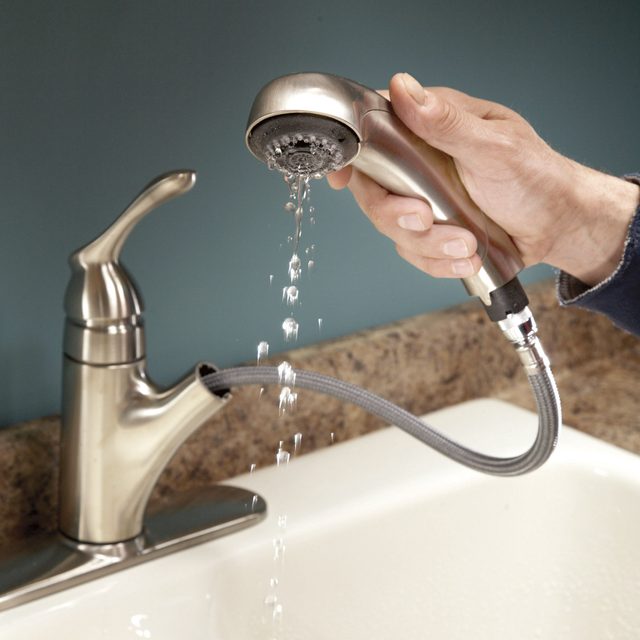Simple fixes for a pull-out faucet
Introduction
If your spray head has a weak flow, the problem is usually a clogged aerator. The aerator is a screen that's either screwed onto the spout or installed at the point where the faucet connects to the spray hose. It can get stopped up by debris in the water, but the most common cause of clogs is scale buildup.
Unclogging an aerator is easy—often, you just need to soak it in vinegar for a few hours to dissolve the scale. But first, you have to find it and remove it. We show you how to do this and to troubleshoot other possible problems as well.
Video: How to Unclog a Drain
Tools Required
- Adjustable wrench
- Pliers
Project step-by-step (4)
Unscrew the sprayer
Turn off the water at the faucet and use pliers to loosen the nut that holds the sprayer to the flexible hose. Remove the sprayer. Hold the tube facing down into the sink and gradually turn on the water at the faucet to check the water pressure.
Low water pressure in kitchen faucet?
If your pullout sprayer delivers a weak spray, here’s what to do. But first, make sure the problem is with the spray head and not farther down the line.
Start by removing the sprayer. Clip a clothespin or small clamp on the hose to keep it from snaking back down the spout. If water gushes from the hose when you turn on the faucet, then you know the problem is in the spray head. If the flow is still weak, there’s a problem with the faucet or supply lines. Type “faucet repair” into the search box above for help with this problem.

Clean the inlet screen
Look down into the hose end of the sprayer and see if there’s a small screen. If there is, remove it by tapping the sprayer or gently prying it out with a small pointed tool.
Most pullout sprayers have an inlet screen, a removable aerator or both, and they can get clogged with mineral deposits or other debris. There are dozens of different types of pullout spray faucets, though, and they all have slightly different parts, so yours may not look exactly like this. The biggest difference is in how you remove the aerator. On some faucets, the aerator has flat spots for a wrench or pliers and you simply unscrew it. Other faucets require a special tool (sometimes included with new faucets) for unscrewing the aerator.
You can clean out the holes in the inlet screen with a dental pick or other pointed tool, but it’s easier to just soak the aerator in vinegar, which will effectively dissolve scale and other debris. If that doesn’t work, take the aerator to a hardware store, home center or plumbing supplier to find a replacement. If you can’t find a match, go to the manufacturer’s website to find out how to order one.

Check the backflow preventer
Inspect the area under the inlet screen to see if there’s a backflow preventer. Gently press a pencil against this round disc to make sure it moves freely. Clean off any mineral deposits around the edges.
Kitchen Cleaning Checklist: 11 Tips for a Clean Kitchen

Check the aerator
Unscrew the aerator with a pliers or wrench. Some pullout spray heads don’t have removable aerators. Check with the manufacturer if you can’t tell.
If these fixes don’t work or you don’t want to do them, you can always replace the entire spray head, but first contact the manufacturer of your faucet. It may be under warranty, in which case you should be able to get a new spray head for free.
If not, go to the manufacturer’s website for information on ordering a new one (it will cost about $30 to $40). Also, many home centers stock a generic replacement that fits most faucets (about $25).

FAQ
How often should I clean my faucet aerator?
You only need to clean the aerator when it’s clogged and water pressure is low. Depending on the hardness of your water, that could take one year or several. If you want to avoid water-pressure problems, you could proactively clean the aerator once or twice a year.
Why is my water pressure still low after cleaning the aerator?
If cleaning the aerator doesn’t restore water pressure, the first thing to do is look for an inline filter in the hose behind the spray head, which you’ll find on many contemporary pull-out faucets. Check the faucet manual for instructions on how to find and remove it, then soak it overnight in vinegar.
The next most likely culprits are the faucet’s shut-off valves under the sink. Make sure they are completely open. If pressure is still low, you may be dealing with a systematic problem like a leak, a blockage in the water supply lines or some other problem with the water pressure in the house. If so, it may be time to call a plumber.




















